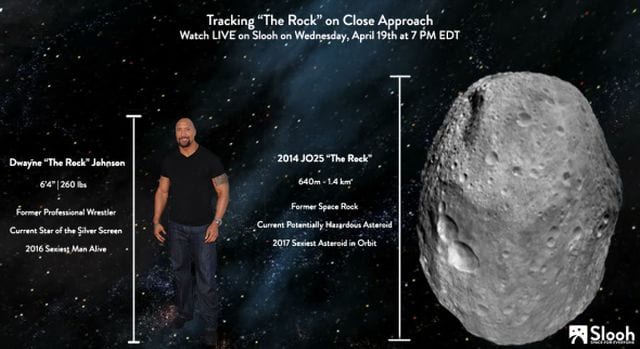A huge asteroid is spotted nearby our planet, and it is traveling at 33 kilometers per second, which means that it will go past the Earth on Thursday morning. This only reminds us that cosmos is a dangerous place with all kinds of activities.
Brad Tucker, an astronomer at the Australian National University, said: “This tells us how active space is – it’s not static. We are so used to hearing astronomers describing objects as light years away. Close encounters with asteroids are things that happen on a real time scale.”
This asteroid is called 2014-JO25 and nicknamed The Rock, and it will come closer to our planet than any other asteroid in the last 13 years. Luckily for us, it will go past about 1.8 million kilometers away. The nickname “The Rock” is interesting because it reminds us of the famous actor Dwayne Johnson. Professor Tim Bedding, who is the chief of the school of physics at the University of Sydney, stated: “If an asteroid this size hit Earth, it would be catastrophic. If it hit an ocean, the tsunamis it would raise could wipe out coastal cities. If it hit land, it would be a different scenario but in both cases completely catastrophic.”
Tucker stated: “In the grand scheme of things, yes it is close because space is big. If it hit, its impact would be on the order of 10,000 megatons of TNT. Our real worry is not something a kilometer long, that’s easy to spot. We know where most of these are. Something much smaller, such as the one that exploded over Chelyabinsk in Russia three years ago is more of a threat. That could come out of nowhere. That was about 10 or 20 meters – and that can cause enough damage if it hits the right place. Those we know only a very few percent. We are still undoing all the damage that Armageddon did. Bruce Willis destroyed 10 years of science communication efforts in one poorly made movie. We’re just not going to have a rogue asteroid that comes out of nowhere to destroy the Earth.”
Professor Bedding said: “The most important thing is to detect big asteroids early so you can measure accurately their orbit. And if there is a chance they might intersect with Earth you have – hopefully – years or even decades to do something about it.”
Tucker continued: “Yes, we are going to have something that hits the Earth eventually. That is inevitable. But the planet has been around for 4.5 billion years and we only know of a few rare instances of very large impacts, so they are not common.”
A part of the Nasa’s program is to track asteroids and the one asteroid that actually poses the biggest impact threat to Earth is the one called 29075 which is 1.3 kilometers long. It will be close to Earth on March 16, 2880, and the possibility of impact is one in 8300. The chance that this asteroid will miss the Earth is 99.988 percent. During the “Planetary Defence Exercise” that will be held next month in Japan, Nasa will simulate the approach of a 100-250-meter-wide asteroid and the agencies will have to react. This is going to be the simulation of the possible impact in 2027.
Tucker said: “Every 100 million years or so you could expect one of these kilometre-sized asteroids to hit and release 10,000 megatons worth of energy – that’s about half a million atom bombs the size of which destroyed Hiroshima in 1945.” The asteroid which killed the dinosaurs was 10 times larger than The Rock. The passing of the asteroid will be screened by the robotic telescope service Slooh.
Professor Bedding said: “There are few clever ideas about how to move asteroids if any become a serious threat to Earth. You could paint one side of an asteroid black so it heats up in a particular way and the solar heat causes it to move out of harm’s way. Breaking it up into pieces like in Armageddon won’t help as the pieces all come and hit the Earth anyway.”









